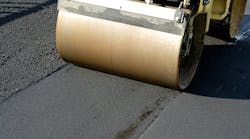About the author: Ohio city reconstructs flood-prone street with permeable pavers
City officials in New Albany, Ohio, were in a quandary. Located near the village center, Third Street’s asphalt surface was both unsightly and in disrepair. At the downhill end, the Rose Run stream flooded frequently, which seriously hindered property development.
Further asphalt testing confirmed what had been suspected: The damage was beyond a routine re-milling and resurfacing job; a complete and thorough reconstruction was needed. The street and storm drain would have to be dug out and completely rebuilt. These measures alone, however, would not solve the storm water issue with Rose Run. The water would have to be redirected off site somehow.
The challenge was to design a new street that would look good, last long and resolve the storm water problem. On top of that, the project had to be done amid the budgetary constraints that are a fact of life these days in every municipality.
The solution was to use clay brick pavers in a best practices permeable pavement installation. The installation effectively achieved each of the goals set by the planners and engineers: aesthetics, durability, resolution of storm water issues and, most importantly, cost.
“Working with the storm water master plan associated with this project, we generated some concepts to explore the best methods to deal with storm water drainage,” said Franco S. Manno, ASLA, LEED AP, senior landscape architect for Columbus, Ohio-based engineering firm EMH&T. “Our design options included bioretention, rain gardens, pervious pavement and other green infrastructure. Pervious pavement was the one that made the most sense with this project.”
Manno said that the advantages inherent in the clay brick pavers were apparent after several mockups were made on site to show how the pavers would look in daily use. StormPave in the Ironspot color, by Winston-Salem, N.C., brick maker Pine Hall Brick Co., was specified for the street. An English Edge conventional clay paver, similar in appearance to StormPave, was specified for sidewalks next to the street.
In a cost-benefit analysis, installing permeable pavers was the city’s preferred option. The cost to maintain the permeable pavers is negligible; it involves regularly sweeping or vacuuming debris from between the pavers, and sweeping more aggregates between them if needed.
Additional savings are realized because no underground storm drains are needed. The installation effectively captures and holds storm water until it seeps naturally into the earth below.
On Site
The street first was excavated, with deeper excavation on the end closest to Rose Run. A 13- to 52-in. sub-base of 1½- to 3-in. clean fractured open-graded aggregate (ASTM D448 No. 2) was applied. Atop that, a 4-in. choker course of ¾-in. aggregate (ASTM D448 No. 57) was placed, followed by a 2-in. setting bed of ¼- to 3/8-in. aggregate (ASTM D448 No. 89). The clay pavers were laid on top of the setting bed and additional No. 57 aggregate was swept between them to provide interlock.
The idea behind this type of installation is that during a rainstorm, the water hits the pavers and then infiltrates around and between them to the aggregate below. The water is held in the void area of the course-grade aggregate underneath until it seeps into the earth, where it is filtered naturally as it refills the water table. In heavier rainfall, water filters through the aggregate and then downhill along the subgrade, where it is held in the deeper section of course-grade aggregate. It then passes through a sand filter before the remaining water is released, in this case, into Rose Run.
Beyond Cost & Aesthetics
In addition to cost savings and aesthetics, using permeable pavers
means that less land needs to be set aside for drainage ponds to address storm water issues, leaving more land available for development. Therefore, businesses planning to build new developments will have fewer storm water issues to engineer.
“It is no small feat to simultaneously improve our Rose Run stream and enable redevelopment,” said Village Adminstrator Joe Stefanov. “We’re accomplishing both.”
The installation also means the area will be safer. “These new pavers will drain better, producing less ice on the surface,” said Public Service Director Mark Nemec. “Plus, because brick streets usually slow traffic, we expect a safer environment for motorists and pedestrians alike.”
What has not changed is the weather in Ohio—but the new street surface is tough enough to stand up to it.
The American Society for Testing & Materials has several requirements for pavers (ASTM C902 and C1272) that are used in severe freezing and thawing conditions. Those requirements include:
- No more than 8% water absorption. StormPave pavers have 4% to 6% water absorption.
- A maximum cold-to-boiling water absorption of 0.78, which measures the ability of the paver to withstand water expansion in freezing conditions. StormPave has an average of 0.58.
- Compressive strength of at least 8,000 psi and breaking loads in excess of 475 lb per inch. On average, StormPave carries a compressive strength of greater than 12,000 psi and averages 1,253 lb per inch breaking load.
StormPave pavers are green in two ways. They help purify water, and they are made out of shale and water; shale is an abundantly available natural building material.
“When we found out Third Street needed to be totally reconstructed, we wondered if we could do something more sustainable and environmentally friendly,” Stefanov said. “It turned out that we could, while staying under budget. Initial brick construction was only slightly more expensive than asphalt and we expect maintenance and operational costs to be significantly reduced over the lifetime of the project. I am glad we were able to complete such an aesthetically pleasing project that is also environmentally friendly.”
Download: Here


